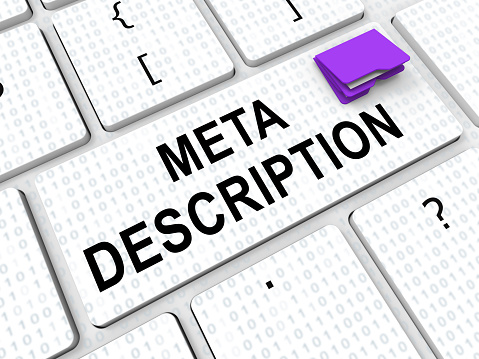Since meta descriptions are critical for on-page SEO, they must be optimized for both readers and search engines. We explain how meta descriptions operate and give a strategy for developing meta descriptions that can help your online business prosper in the sections below.
What is a Meta Description?
A meta description is a 160-character snippet of text that explains the content of a page. If you’ve ever used a search engine like Google, you’ve probably seen meta descriptions.
When you type a search query into Google, you’ll be provided with a SERP (search engine results page) (Search Engine Results Page). You’ll find a variety of results connected to your search query on this SERP.
What are the Benefits of Meta Descriptions?
You’ll want to do everything you can as a store owner to bring your merchandise in front of potential clients. From three key sources — search engine results, social media shares, and social bookmarks — meta descriptions can help you increase your clickthrough rate. A meta description can assist you to secure the attention of a reader in all three of these sources by providing more information about the page.
Although search engines have stated that meta descriptions are not directly used in the ranking algorithm, Google does evaluate a page’s CTR (Click Through Rate) to determine how well your webpage matches the search query. Meta descriptions are an excellent strategy to improve your Google ranking because they help you enhance your web page’s CTR.
You will receive more visits if you have a higher Google ranking. More traffic to your store equals more prospective consumers, which means you’re more likely to make sales. After all, Google has more than one billion monthly active users!
How Long Should a Meta Description Be?
The recommended length for a meta description is 155-160 characters. Although there is no penalty for exceeding 160 characters, search engines generally limit snippets to that length. To keep track of your meta description characters, utilize a site like Charactercountonline or Lettercount.
How to Write a Good Meta Description
Now that we’ve discussed the purpose of a meta description, let’s look at how to write one that will increase the amount of traffic to your online business.
It’s vital to remember that meta descriptions for home pages and product pages are not the same things. Below is a step-by-step approach to writing meta descriptions for both home and product pages:
Homepage
When crafting a meta description for your homepage, you’ll only have 160 characters to describe your company’s overall message. Even if you are an accomplished writer, this is a challenging assignment.
It’s always a good idea to keep meta descriptions basic while coming up with a convincing cause to click on the page as a general guideline. When potential buyers use Google, they won’t even realize why they’ve made a decision – all they’ll see is your enticing meta description language and then click on the link.
Product Page
Generating a meta description for a product page differs differently from creating one for a home page. Rather than expressing your brand’s vision in just 160 characters, you’ll need to inform potential buyers about the benefits they’ll receive if they visit your product page.
It’s a good idea to highlight your product’s unique selling qualities in the meta description, as this is the most likely way to attract new buyers.
Creating Meta Descriptions That Are Mobile-Friendly
When it comes to optimizing your online business for search engines, it’s vital to consider mobile users. Around 69 percent of all internet users are said to use mobile for product research, and that number is expected to rise in the future.
When writing meta descriptions for your pages, it’s a good idea to keep this in mind. We recommend using Yoast or Rankmath because their tool has options that allow you to switch between mobile and desktop meta descriptions.
In terms of writing meta descriptions for a mobile audience, strive to keep title tags around 40-60 characters and meta descriptions under 90 characters. This is because, on a mobile SERP, there are fewer characters displayed due to the smaller screen sizes.
6 Meta Description and CTR Optimization Tips
You’ll learn the best writing approaches as you create your own meta descriptions, whether you’re an experienced SEO writer or this is your first time optimizing a web page. Before you go into descriptions on your own, we’ve put up a list of 6 ideas to help you improve your meta descriptions and boost your store’s CTR:
Respond to the User’s Query
To locate answers, people use search engines such as Google. It doesn’t matter if the user’s inquiry is “is Berlin hot in the summer?” or “how to become rich with dropshipping?” – if you can answer it in your meta descriptions, you’ll be able to encourage curious readers to click on your material.
Double-Check that your Meta Descriptions are Accurate
When creating a meta description, it’s critical that the copy is relevant not only to the Title Tag but also to the search phrase that the user is looking for. Your viewers will be confused and reluctant to click on your page if your meta description includes information about handbags while you’re offering sunglasses.
Ensure Your Message is Home
When it comes to meta descriptions, 60 characters isn’t much to work with. When you’ve decided on the messaging you want to utilize, try to fit as much of it into the character restriction as possible. Every word should have a purpose, and that purpose should be to boost your CTR.
Create a Copy of an Enticing Meta Tag
According to studies, if your page has intriguing material, 8 out of 10 viewers will click on it. Take advantage of this knowledge and write the BEST page titles you can. This will greatly aid your store’s traffic generation and security.
Use CTA to your Advantage
Including a CTA (Call To Action) in your meta description is excellent. A call to action (CTA) such as “buy now” is a direct order that may prompt your users to act and purchase a product from your store.
Employ Active Voice
When writing meta descriptions, it’s always ideal to utilize the active voice. Use the phrase “Find all the best styles” instead of “All the best styles are found here.” Instead of making a suggestion, this sends an order to potential buyers.
Conclusion
You are now prepared to develop excellent meta descriptions for your pages. You should follow the techniques and tactics in this article to start producing more organic traffic to your ecommerce business right away.
In essence, these are all of the processes for producing effective meta descriptions:
- Respond to questions with your description.
- Make certain that your meta description copy is related to the search purpose.
- Make the most of the meta description length.
- Use appealing copy in your meta description element.
- Make use of call-to-actions.
- Use active voice when writing.
If you have any further questions concerning meta descriptions, leave them in the comments area below. We’d love to assist you on your entrepreneurial path.



